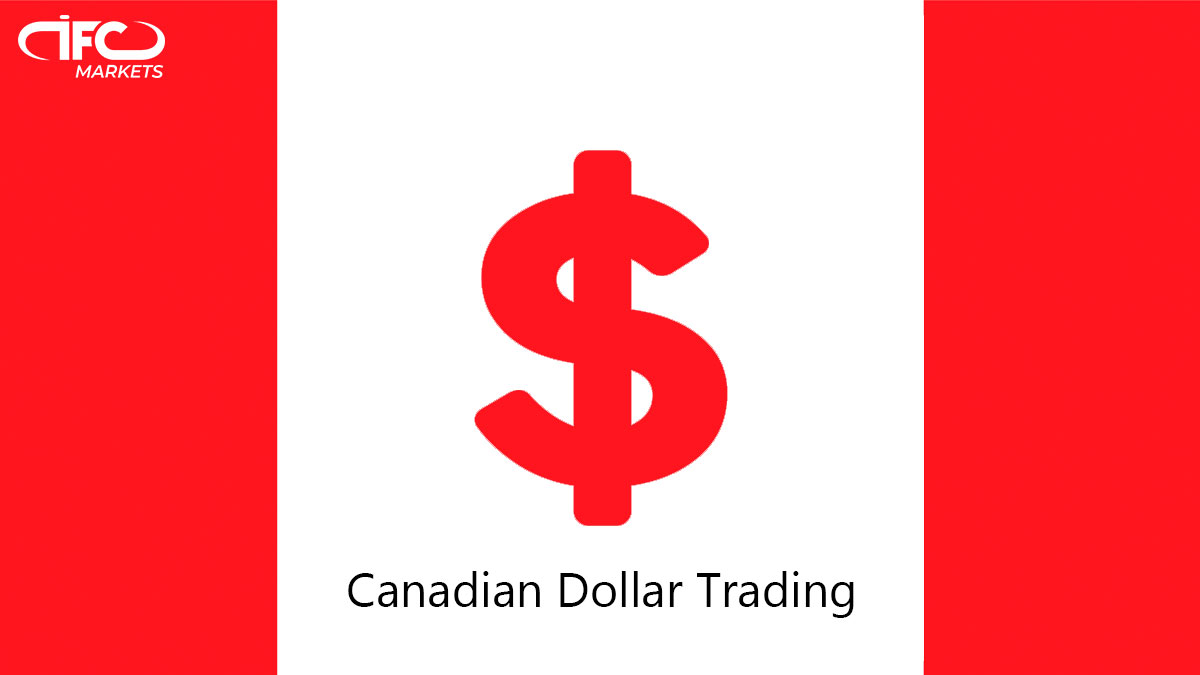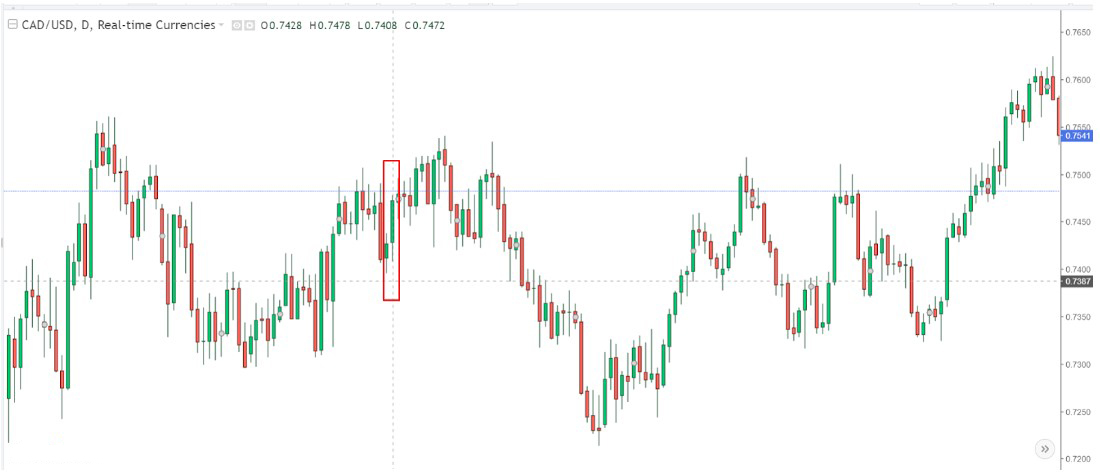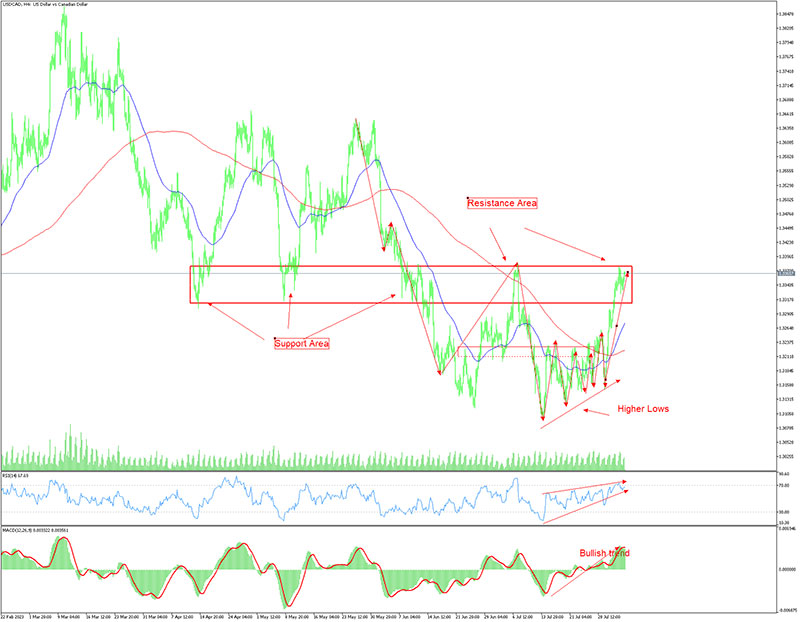- Education
- About Forex
- Canadian Dollar Trading
Canadian Dollar Trading
The Canadian dollar, denoted as CAD or simply referred to as the "loonie," holds a prominent position in the global foreign exchange market. As one of the major currency pairs, USDCAD, has captivated the attention of traders worldwide. Understanding the factors that influence the Canadian dollar's movements is essential for successful trading in this vibrant market.
In the Canadian Dollar Trading article, we will delve into the intricacies of the Canadian dollar, exploring the key drivers behind its fluctuations and how traders can capitalize on its volatility. Whether you're an experienced forex trader or just venturing into the exciting world of currency trading we will equip you with valuable insights on how to navigate the twists and turns of the Canadian dollar's trajectory.
From analyzing economic indicators that impact CAD's value to exploring technical analysis tools to refine your trading strategies, we leave no stone unturned in our quest to enhance your trading prowess.
So, let's dive in!

KEY TAKEAWAYS
- Canadian Dollar (CAD) Trading: Involves buying and selling the CAD in the forex market, with USDCAD being a popular currency pair.
- Factors Impacting CAD: Economic indicators, interest rates, commodity prices, trade balance, geopolitical events, and global market sentiment all influence the CAD's movements.
- Trading Strategies: Traders use fundamental and technical analysis, combining both approaches to make informed decisions.
- Technical Analysis: Technical indicators like moving averages, MACD, and RSI can provide insights into potential trends in the USDCAD pair.
- Bank of Canada's Influence: The Bank of Canada's interest rate decisions and monetary policies play a crucial role in shaping the CAD's value in the medium term.
Canadian Dollar Trading
Canadian Dollar Trading refers to the buying and selling of the Canadian dollar (CAD) in the foreign exchange market. The Canadian dollar is the official currency of Canada and is denoted by the symbol "CAD." It is one of the major currencies in the global forex market and is commonly traded against other major currencies, with the most popular currency pair being USDCAD, which represents the exchange rate between the Canadian dollar and the US dollar.
Trading the Canadian dollar involves speculating on its value in relation to other currencies, aiming to profit from fluctuations in the exchange rates. Traders and investors analyze various factors that can influence the Canadian dollar's value, such as economic indicators, interest rates, inflation, trade balances, geopolitical events, and market sentiment.
Forex traders use different trading strategies, including fundamental analysis, technical analysis, and a combination of both, to make informed decisions about when to buy or sell the Canadian dollar. They can trade the Canadian dollar through various financial instruments, such as spot forex, futures contracts, options, and exchange-traded funds (ETFs).
The Canadian dollar's value can be impacted by domestic factors, such as economic growth, employment data, and central bank policies, as well as global factors, like changes in commodity prices (Canada being a major exporter of commodities) and geopolitical developments. As a result, Canadian dollar trading can be dynamic and present both opportunities and risks for traders seeking to capitalize on currency movements.
Overall, Canadian dollar trading is an integral part of the foreign exchange market and plays a significant role in the international financial landscape, attracting traders and investors from around the world looking to profit from the loonie's fluctuations.
Whether you're trading forex, stocks, commodities, or cryptocurrencies, MetaTrader 4 provides a seamless and efficient trading experience. So don't go far, download MetaTrader 4 Trading platform.
What Moves Canadian Dollar
There are several factors that influence the movement of the Canadian dollar (CAD) in the foreign exchange market. The value of the Canadian dollar can fluctuate based on a combination of both domestic and global factors.
Let’s find out what moves Canadian Dollar:
- Economic Indicators: Economic data such as gross domestic product (GDP) growth, employment figures, inflation rates, and consumer spending can significantly impact the Canadian dollar's value. Positive economic indicators often strengthen the CAD, while negative data can lead to its depreciation.
- Interest Rates: The Bank of Canada sets the country's benchmark interest rate, and changes in interest rate policies can affect the Canadian dollar's attractiveness to investors. Higher interest rates tend to attract foreign capital seeking higher returns, increasing demand for the CAD and driving up its value.
- Commodity Prices: Canada is a major exporter of commodities, including oil, natural gas, metals, and agricultural products. Fluctuations in commodity prices can have a significant impact on the Canadian dollar, as higher commodity prices typically strengthen the CAD due to increased export revenue.
- Trade Balance: Canada's trade balance, which measures the difference between exports and imports, can influence the currency's value. A positive trade balance (exports exceed imports) can strengthen the CAD, while a negative trade balance may weaken it.
- Geopolitical Events: Political and geopolitical developments, both in Canada and globally, can affect investor sentiment and impact the Canadian dollar. Uncertainty or instability in the political landscape may lead to currency volatility.
- Global Market Sentiment: The Canadian dollar, like other currencies, can be influenced by overall market sentiment and risk appetite. During times of economic uncertainty or market turmoil, investors may seek safe-haven currencies, such as the US dollar, which could lead to a weaker CAD.
- Central Bank Actions: Statements and policies from the Bank of Canada can influence the Canadian dollar's value. For example, indications of potential interest rate changes or quantitative easing measures can impact investor perceptions and currency valuation.
- Correlation with Other Currencies: The Canadian dollar can also be influenced by its correlation with other currencies, particularly its neighboring currency, the US dollar. The USDCAD currency pair is closely watched, and movements in the US dollar can have a direct impact on the Canadian dollar.
Let’s check out on an example how interest rate influenced Canadian dollar
On January 20, 2023, Bank of Canada raised its target overnight rate by 0.25% to 0.50%. Canadian Dollar (CAD): CADUSD exchange rate rose from 0.740 to 0.7500.

When the Bank of Canada raised its interest rate, it made Canadian dollar-denominated investments more attractive to foreign investors. This increased demand for the CAD, which led to an appreciation of the currency.
Want to learn how to trade USDCAD?
How to Trade Canadian Dollar
Here are the steps on how to trade Canadian Dollar with IFC Markets:
- Open a trading account with IFC Markets. You can do this on our website or by contacting the customer support team.
- Fund your account with a minimum deposit of $1.
- Choose a trading platform. IFC Markets offers three trading platforms: MT4, MT5 and NetTradeX.
- Select a trading pair. The Canadian dollar is often traded against the US dollar (USDCAD), but you can also trade it against other currencies such as the euro (EURCAD) or the Japanese yen (JPYCAD).
- Set up your trading strategy. This includes deciding on your trading style (e.g., scalping, day trading, swing trading, or position trading), your risk tolerance, and your profit targets.
- Start trading!
Here are some additional tips for trading Canadian Dollar from IFC Markets:
- Use the latest market data and technical analysis tools to make informed trading decisions.
- Manage your risk carefully. Set stop-losses and take-profits to limit your losses and maximize your profits.
- Stay up-to-date on economic news and events that could affect the Canadian dollar.
- Practice trading on a demo account before you start trading with real money.
IFC Markets is a regulated broker, so you can be sure that your funds are safe. They also offer a variety of educational resources to help you learn how to trade.
Here are some of the benefits of trading Canadian Dollar with IFC Markets:
- Competitive spreads and commissions
- Excellent trading conditions
- Wide range of trading instruments
- User-friendly trading platforms
- 24/7 customer support
If you're interested in trading Canadian Dollar, IFC Markets is a good option to consider. We offer a variety of features and benefits that can help you trade successfully.
Canadian Dollar Technical Analysis
The USDCAD currency pair has been trading in a bearish trend since the beginning of March 2023. The currency has been weighed down by a number of factors, including the rising US dollar, the ongoing trade war between the US and China.
However, there are some signs that the USDCAD may be bottoming out. The currency has recently found support at the 1.30 level, and there is some technical evidence that suggests a bullish reversal may be in the works.
For example, the MACD indicator has recently crossed above its signal line, which is a bullish signal. Additionally, the RSI indicator is now in oversold territory, which suggests that the USDCAD may be oversold and due for a rebound.
Of course, it is important to remember that technical analysis is not always accurate. However, the technical indicators suggest that there is a good chance that the USDCAD may be bottoming out.

Here are some of the key technical indicators to watch for:
- Moving averages: The 200-day moving average is a key support level for the USDCAD. If the currency breaks above this level, it could signal a further uptrend.
- MACD indicator: The MACD indicator is a momentum indicator that can help to identify bullish and bearish trends. A bullish crossover of the MACD signal line would be a positive sign for the USDCAD.
- RSI indicator: The RSI indicator is a volatility indicator that can help to identify overbought and oversold conditions. The RSI is currently in oversold territory, which suggests that the USDCAD may be due for a pullback.
Overall, the technical indicators suggest that the USDCAD may be bottoming out.
It is also important to use technical analysis in conjunction with other factors, such as fundamental analysis, to make informed trading decisions.
Here are some of the key fundamental factors that could affect the USDCAD in the near future:
According to forecasts from the Bank of Canada and market experts, the inflation rate in Canada is expected to be around 3% in the coming year and gradually decrease to 2% by mid-2025. The majority of market participants believe that the Canadian Central Bank will maintain its interest rate at this level or slightly higher until the end of the current year, and they may consider lowering it only in the following year.
These factors suggest that the Canadian Dollar will receive support from the Bank of Canada in the medium term, as long as there are no unexpected changes in their monetary policy towards easing. On Friday at 12:30 (GMT), there is expected to be increased volatility in the USD/CAD currency pair as Canada's Statistics Bureau and the US Labor Department will publish their monthly reports on the state of their respective job markets.
In simpler terms, the Canadian Dollar is expected to remain strong due to the Bank of Canada's cautious approach to reducing inflation and interest rates. However, keep an eye on the reports coming out on Friday, as they could cause fluctuations in the USDCAD exchange rate.
Bottom Line on Canadian Dollar Trading
The Canadian dollar (CAD), also known as the "loonie," is a significant player in the global foreign exchange market. Traded against major currencies, the most popular pair is USDCAD, representing the CAD's value against the US dollar.
Trading the Canadian dollar involves speculating on its value relative to other currencies to profit from exchange rate fluctuations. Traders analyze factors like economic indicators, interest rates, commodity prices, trade balances, geopolitics, and market sentiment.
To trade the CAD effectively, traders use strategies like fundamental and technical analysis. They can do so through various instruments like spot forex, futures contracts, options, and ETFs.
Factors impacting the CAD's value include domestic economic growth, employment data, and central bank policies, as well as global changes in commodity prices and geopolitical events.
Trading the Canadian dollar can be exciting, but it comes with risks. Careful risk management and staying informed about economic news are essential for success.
Remember to practice on a demo account before using real money and consider using regulated brokers like IFC Markets, which offer support, educational resources, and user-friendly trading platforms.
Overall, Canadian dollar trading offers opportunities for traders worldwide, and understanding its influences can enhance your trading skills.
FAQs
How does Forex Work?
Forex (Foreign Exchange) is a huge network of currency traders, who sell and buy currencies at determined prices, and this kind of transfer requires converting the currency of one country to another. Forex trading is performed electronically over-the-counter (OTC), which means the FX market is decentralized and all trades are conducted via computer networks.
What is Forex Market?
The Forex market is the largest and most traded market in the world. Its average daily turnover amounted to $6,6 trillion in 2019 ($1.9 trillion in 2004). Forex is based on free currency conversion, which means there is no government interference in exchange operations.
What is Forex Trading?
Forex trading is the process of buying and selling currencies at agreed prices. Most currency conversion operations are carried out for profit.
What is The Best Forex Trading Platform?
IFC Markets offers 3 trading platforms: MetaTrader4, MetaTrader5, NetTradeX. MT 4 Forex trading platform is one of the most downloaded platforms which is available on PC, iOS, Mac OS and Android. It has different indicators necessary for making accurate technical analysis. NetTradeX is another trading platform offered by IFC Markets and designed for CFD and Forex trading. NTTX is known for its user-friendly interface, reliability, valuable tools for technical analysis, distinguished functionality and the opportunity to create Personal Composite Instruments (PCI) which is available specifically on NetTradeX.

